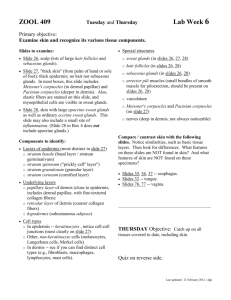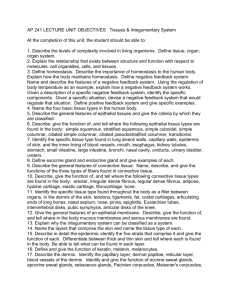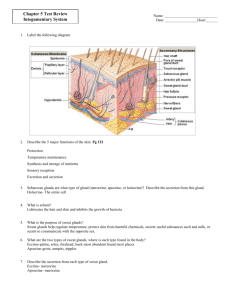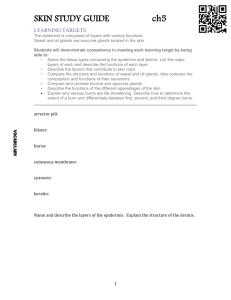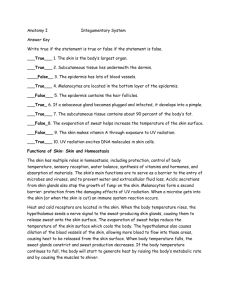Integumentary System
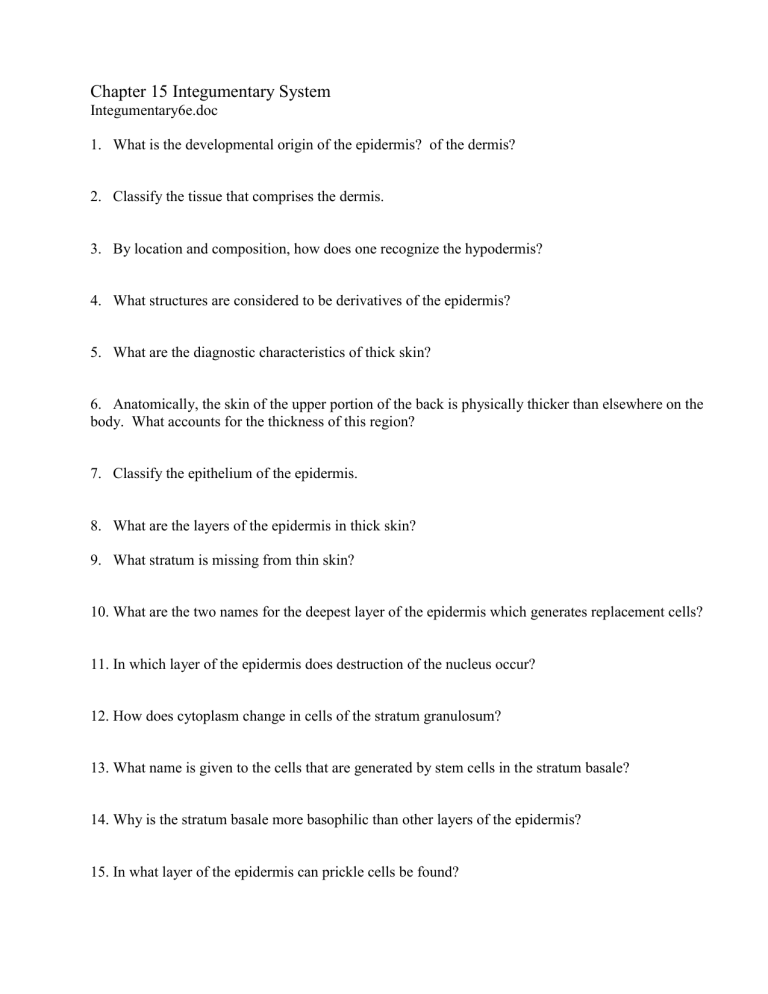
Chapter 15 Integumentary System
Integumentary6e.doc
1.
What is the developmental origin of the epidermis? of the dermis?
2.
Classify the tissue that comprises the dermis.
3.
By location and composition, how does one recognize the hypodermis?
4.
What structures are considered to be derivatives of the epidermis?
5.
What are the diagnostic characteristics of thick skin?
6.
Anatomically, the skin of the upper portion of the back is physically thicker than elsewhere on the body. What accounts for the thickness of this region?
7.
Classify the epithelium of the epidermis.
8.
What are the layers of the epidermis in thick skin?
9.
What stratum is missing from thin skin?
10.
What are the two names for the deepest layer of the epidermis which generates replacement cells?
11.
In which layer of the epidermis does destruction of the nucleus occur?
12.
How does cytoplasm change in cells of the stratum granulosum?
13.
What name is given to the cells that are generated by stem cells in the stratum basale?
14.
Why is the stratum basale more basophilic than other layers of the epidermis?
15.
In what layer of the epidermis can prickle cells be found?
16.
How does cell shape change as prickle cells approach the stratum granulosum?
17.
What is the diagnostic characteristic of cells in the stratum granulosum?
18.
What are the diagnostic characteristics of cells in the stratum corneum?
19.
What constitutes the water barrier of the epidermis?
20.
How does mechanical stress affect the stratum corneum?
21.
How does one recognize the stratum lucidum in histological material?
22.
What are dermal papillae?
23.
What is the relationship of dermal papillae to epidermal ridges (a.k.a. rete ridges)?
24.
What does the length of the dermal papillae indicate regarding the degree of stress in that region of skin?
25.
What and where are dermal ridges?
26.
How is the rate of cells division in the stratum germinativum related to fingerprints?
27.
What are the two layers of the dermis and how are they different?
Note Misprint on p. 493 ….papillary layer includes dermal papillae and epidermal ridges (not dermal ridges as printed in the text.)
28.
What are Langer’s lines and why are they of interest to surgeons?
29.
In what regions does the reticular layer also possess smooth muscle that, when contracted, lead to wrinkling of the skin in those areas?
30.
What is the location and function of the panniculus adiposus? What are two other names for this layer?
31.
What is the role of arrector pili muscles?
32.
What types of muscle comprises the panniculus carnosus and what role does this layer have in the neck, face, and scalp of humans?
33.
What are tonofibrils? How do they affect the staining of keratinocytes?
34.
What is the major histological feature of cells in the stratum granulosum?
35.
Where can hard keratin be found?
36.
What events are associated with keratinazation?
37.
The destruction of what cellular structure is responsible for desquamation?
38.
What are lamellar bodies? Which cells produce them and what is their function?
39.
What are the two components of the epidermal water barrier and where is each found?
40.
What is the site of origin of melanocytes?
41.
Where are melanocytes located and with what type of cell do they associate?
42.
What is the physiological role of melanin?
43.
What is the special means by which melanosomes are transferred to keratinocytes?
44.
How does the location of melanosomes and the rate of degradation of melanin affect skin coloration?
45.
How does one “get a tan” in terms of the processes involving melanin?
46.
Why is skin cancer more common in the elderly?
47.
What is the location and role of Langerhans’ cells? .
48.
Are Langerhans’ cells visible with H&E staining?
49.
Why are Langerhans’ cells of particular interest to HIV patients?
50.
What is the role of Merkle’s cells? P. 500 mechanoreceptor of skin.
51.
What is the role of free nerve endings in the stratum granulosum?
52.
What is the role of free nerve endings adjacent to a hair follicle? .
53.
How are Pacinian corpuscles identified histologically?
54.
What is the function of Pacinian corpuscles?
55.
Where are Meissner’s corpuscles located in great abundance? What is their function?
56.
What type of stimulus activates Ruffini’s corpuscles?
57.
Why are hair follicles, sebaceous glands, and sweat glands called “epidermal skin appendages?”
58.
Why might the secretions of apocrine glands be of interest to perfume and cologne producers?
59.
What cells are responsible for the color of hair?
60.
Which skin appendage in involved in holocrine secretion? .
61.
What is the cause of acne lesions?
62.
What is the lifespan of a sebaceous cell and how are sebaceous cells replaced?
63.
What are the two types of sweat glands? Where are each type found?
64.
What are the functions of eccrine sweat glands?
65.
In which layers of the skin is the secretory portion of a sweat gland located?
66.
What is the neural basis of “sweaty palms?”
67.
What is the location and function of myoepithelial cells in an eccrine sweat gland?
68.
Classify the epithelium of a sweat gland duct.
69.
How can one recognize apocrine sweat glands in histological material?
70.
Where do apocrine glands release their secretions?
71.
Where is the secretory portion of an apocrine gland located?
72.
How is the secretory portion of apocrine gland distinguished from an eccrine gland?
73.
By what type of secretion (holocrine, apocrine, or merocrine) do apocrine secretions enter the lumen of the gland?
74.
How do apocrine secretions come to have an acrid odor?
75.
What is unusual about the autonomic innervation of eccrine sweat glands?
76.
What types of stimuli promote secretion from apocrine glands?

